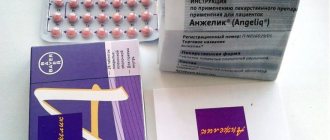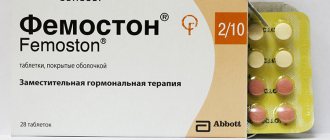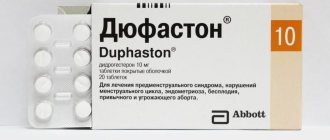Angeliq instructions for use, contraindications, side effects, reviews
Combined drug for continuous hormone replacement therapy (HRT). Drug: ANGELIK Active substance of the drug:
drospirenone, estradiol ATC coding: G03FA17 KFG: Anticlimacteric drug Registration number: P No. 016029/01 Registration date: 07/14/08 Owner of reg. credential: BAYER SCHERING PHARMA AG {Germany}
Angeliq release form, drug packaging and composition.
Medium red (dark pink) film-coated tablets, round, biconvex, embossed “DL” in a regular hexagon on one side. 1 tab. estradiol (in the form of hemihydrate) 1 mg drospirenone 2 mg
Excipients: lactose monohydrate, corn starch, modified starch, talc, magnesium stearate, polyvidone 25000, hydroxypropyl methylcellulose, polyethylene glycol 6000, titanium dioxide, red iron oxide.
28 pcs. - blisters (1) - cardboard packs.
The description of the drug is based on the officially approved instructions for use.
Pharmacological action of Angelique
A combination drug for continuous hormone replacement therapy (HRT), which avoids regular withdrawal bleeding.
Contains estrogen - 17-estradiol, identical to endogenous, and drospirenone, which has a gestagenic, antigonadotropic and antiandrogenic, as well as antimineralocorticoid effect.
Estradiol replenishes the deficiency of estrogen in the female body after menopause and provides effective treatment of psycho-emotional and vegetative menopausal symptoms (such as hot flashes, increased sweating, sleep disturbances, increased nervous excitability, irritability, palpitations, cardialgia, dizziness, headache, decreased libido, muscle and joint pain); reduces involution of the skin and mucous membranes, especially the genitourinary system (i.e. has a positive effect on urinary incontinence, dryness and irritation of the vaginal mucosa, pain during sexual intercourse).
Estradiol prevents bone loss caused by estrogen deficiency, which is mainly associated with suppression of osteoclast function and a shift in the process of bone remodeling towards bone formation. Long-term use of HRT has been shown to reduce the risk of peripheral bone fractures in women after menopause. When HRT is discontinued, the rate of bone mass decline is comparable to that characteristic of the period immediately after menopause. It has not been proven that HRT can restore bone mass to premenopausal levels.
HRT also has a beneficial effect on the collagen content of the skin, as well as its density, and may also slow down the formation of wrinkles.
Drospirenone, due to its antiandrogenic properties, has a therapeutic effect on androgen-dependent diseases such as acne, seborrhea, androgenetic alopecia.
Drospirenone has antimineralocorticoid activity, increases the excretion of sodium and water, which can prevent increased blood pressure, weight gain, edema, breast tenderness and other symptoms associated with fluid retention. After 12 weeks of using the drug Angeliq, a slight decrease in blood pressure was observed (systolic - on average by 2-4 mm Hg, diastolic - by 1-3 mm Hg). Other studies noted a decrease in SBP by 9 mmHg. Art. and DBP by 5.7 mmHg. Art. In women with normotension, blood pressure did not change significantly. The effect on blood pressure was more pronounced in women with arterial hypertension. After 12 months of using the drug Angeliq, the average body weight remained unchanged or decreased by 1.1–1.2 kg.
Drospirenone is devoid of any androgenic, estrogenic, glucocorticoid and antiglucocorticoid activity, does not affect glucose tolerance and insulin resistance, which, in combination with antimineralocorticoid and antiandrogenic effects, provides drospirenone with a biochemical and pharmacological profile similar to natural progesterone.
Taking Angelica leads to a decrease in total cholesterol (TC) and LDL-C, as well as a slight increase in triglyceride levels.
The inclusion of drospirenone in the drug prevents the development of endometrial hyperplasia and cancer.
Observational studies suggest that the incidence of colon cancer is reduced among postmenopausal women using HRT. The mechanism of action is still unclear.
Angelique has a positive effect on well-being and quality of life, mainly expressed in a decrease in somatic symptoms, feelings of anxiety/fear, and an improvement in cognition (cognitive function).
Pharmacokinetics of the drug.
Estradiol
Suction
After taking the drug orally, estradiol is quickly and completely absorbed from the gastrointestinal tract. Subjects to a “first pass” effect with the formation of estrone, estriol and estrone sulfate. Bioavailability when taken orally is about 5% and is independent of food intake. Cmax of serum estradiol is approximately 22 pg/ml and is achieved after 6-8 hours.
Distribution
Binds to albumin and sex steroid binding globulin (GSBS). The free fraction of estradiol in serum is approximately 1-12%, and bound SHPS is 40-45%. Vd after a single intravenous injection is about 1 l/kg.
After repeated use, the concentration of estradiol is approximately 2 times higher than after a single dose, while Css varies from 20 pg/ml to 43 pg/ml. After discontinuation of use, levels of estradiol and estrone return to baseline values within approximately 5 days.
Angelique Micro
Not used for contraception.
If you suspect pregnancy, you should stop taking the pills until pregnancy has been ruled out.
If any of the following conditions/diseases or risk factors are present or worsened, before starting or continuing to take the drug, the individual risk-benefit ratio of treatment should be assessed, taking into account the possible need to discontinue it.
When prescribing HRT to women who have several risk factors for the development of thrombosis or a high degree of severity of one of the risk factors, the possibility of mutually enhancing the effect of risk factors and the prescribed treatment on the development of thrombosis should be taken into account. In such cases, the total value of the existing risk factors increases. If there is a high risk, the drug is contraindicated.
Venous thromboembolism
A number of controlled randomized as well as epidemiological studies have revealed an increased relative risk of developing venous thromboembolism (VTE), i.e. deep vein thrombosis or pulmonary embolism, against the background of HRT. Therefore, when prescribing the drug to women with risk factors for VTE, the risk-benefit ratio of treatment should be carefully weighed and discussed with the patient.
High risk factors for developing VTE include individual and family history (the presence of VTE in close relatives at a relatively young age may indicate a genetic predisposition) and obesity with a body mass index of more than 30 kg/m2. The risk of VTE also increases with age.
The possible role of varicose veins in the development of VTE remains controversial.
The risk of VTE may temporarily increase with prolonged immobilization, 'major' elective and post-traumatic surgery, or major trauma. In case of prolonged immobilization or planned surgery, the drug should be stopped 4-6 weeks before surgery; resumption of use is possible only after the woman’s motor activity is completely restored.
Treatment should be stopped immediately if symptoms of thrombotic disorders appear or if their occurrence is suspected.
It is necessary to assess the ratio of individual risk and benefit of treatment in women using HRT drugs in conjunction with anticoagulants.
Arterial thromboembolism
Randomized controlled trials with long-term use of conjugated equine estrogens (CEE) and medroxyprogesterone acetate (MPA) did not provide evidence of a beneficial effect on the cardiovascular system. Large-scale clinical trials of the combination of CLE and MPA revealed a possible increase in the risk of coronary heart disease (CHD) in the first year of use, followed by a lack of beneficial effect. One large clinical trial using CLE alone found a potential reduction in the incidence of CAD among women aged 50–59 years, but no overall benefit in the overall study population. As a secondary outcome, two large clinical trials using CLE either alone or in combination with MPA found a 30-40% increase in the risk of stroke. It is therefore unknown whether this increased risk applies to HRT products containing other types of estrogens and progestogens or to non-oral routes of administration.
Endometrial cancer
With long-term estrogen monotherapy, the risk of developing endometrial hyperplasia or carcinoma increases. The addition of drospirenone prevents the development of endometrial hyperplasia caused by estrogen. If there is a history of endometrial hyperplasia, estrogens alone or in combination with gestagens should be used with caution.
Mammary cancer
Clinical and observational studies have found an increase in the relative risk of developing breast cancer in women using HRT for several years. This may be due to earlier diagnosis, accelerated growth of an existing tumor during HRT, or a combination of both factors. The relative risk increases with duration of therapy but may be absent or reduced with estrogen-only treatment. This increase is comparable to the increased risk of breast cancer in women with a later onset of natural menopause, as well as with obesity and alcohol abuse. The increased risk gradually decreases to normal levels over several years after stopping HRT.
The increased risk of breast cancer has been suggested based on the results of more than 50 epidemiological studies (risk ranges from 1 to 2).
Two large randomized trials of CLE alone or in combination with MPL reported estimated risk ratios of 0.77 (95% confidence interval: 0.59 to 1.01) or 1.24 (95% confidence interval: 1.01 to 1.54) after approximately 6 years of use HRT. It is unknown whether this increased risk also applies to other HRT drugs. HRT increases mammographic breast density, which in some cases may have a negative effect on X-ray detection of breast cancer.
When prescribing the drug to women with risk factors for the occurrence of estrogen-dependent tumors (for example, first-degree relatives with breast cancer), the risk-benefit ratio of treatment should be carefully weighed and discussed with the patient.
Ovarian cancer
A study of estrogen in combination with a progestin showed a statistically non-significant increase in the risk of ovarian cancer. The relative risk of developing ovarian cancer with conjugated estrogens with MPA compared with placebo was 1.58 (95% confidence interval: 0.77-3.24) after a median follow-up of 5.6 years. The absolute risk of conjugated estrogens with MPA compared with placebo was 4 versus 3 cases per 10,000 woman-years. Long-term use of estrogen-only HRT (5-10 years) was associated with a slightly increased risk of ovarian cancer. Long-term use of combination HRT drugs may have the same or slightly lower risk of developing ovarian cancer.
Liver tumor
During the use of sex hormones, which also include drugs for HRT, in rare cases benign, and even more rarely, malignant liver tumors were observed. In some cases, these tumors have led to intra-abdominal bleeding, which is life-threatening. If there is pain in the upper abdomen, an enlarged liver, or signs of intra-abdominal bleeding, the differential diagnosis should take into account the possibility of a liver tumor.
Cholelithiasis
It is known that estrogens increase the lithogenicity of bile. The risk of developing cholelithiasis increases 2-4 times when treated with estrogen.
Dementia
There is limited clinical trial data on a possible increased risk of dementia in women starting CLE-containing medications aged 65 years or older. As observed in studies, the risk may be reduced if CLE-containing HRT medications are started in early menopause.
Other conditions/diseases
Treatment should be stopped immediately if migraine-like pain or frequent and unusually severe headaches appear for the first time, as well as if other symptoms appear that are possible precursors of a thrombotic stroke of the brain.
The relationship between HRT and the development of clinically significant arterial hypertension has not been established. A slight increase in blood pressure has been described in women taking HRT; clinically significant increases are rare. However, in some cases, if persistent clinically significant arterial hypertension develops while taking HRT, discontinuation of HRT may be considered.
In renal failure, the ability to excrete potassium may be reduced. Taking drospirenone does not affect the concentration of potassium in the blood plasma in patients with mild to moderate forms of renal failure. The risk of developing hyperkalemia cannot theoretically be excluded only in the group of patients in whom the concentration of potassium in the blood plasma before treatment was determined at the upper limit of normal, and who additionally take potassium-sparing drugs.
For mild liver dysfunction, including various forms of hyperbilirubinemia, such as Dubin-Johnson syndrome or Rotor syndrome, medical supervision is necessary, as well as periodic liver function tests.
If liver function indicators deteriorate, the drug should be discontinued.
In case of recurrence of cholestatic jaundice or cholestatic itching, which was observed for the first time during pregnancy or previous treatment with sex hormones, the drug should be stopped immediately.
Special monitoring of women is necessary when triglyceride concentrations increase. In such cases, the use of HRT may cause a further increase in the concentration of triglycerides in the blood, which increases the risk of acute pancreatitis.
Although HRT may affect peripheral insulin resistance and glucose tolerance, there is usually no need to change the treatment regimen of diabetic patients when undergoing HRT. However, women with diabetes should be monitored when undergoing HRT.
Some patients may develop undesirable effects of estrogen stimulation, such as abnormal uterine bleeding. Frequent or persistent pathological uterine bleeding during treatment is an indication for examination of the endometrium in order to exclude an organic disease.
Under the influence of estrogens, uterine fibroids can increase in size. In this case, treatment should be stopped.
It is recommended to discontinue treatment if endometriosis relapses during HRT.
If prolactinoma is suspected, this disease should be excluded before starting treatment. If prolactinoma is detected, the patient should be under close medical supervision (including periodic assessment of prolactin concentrations).
In some cases, chloasma may occur, especially in women with a history of chloasma during pregnancy. During drug therapy, women with a tendency to develop chloasma should avoid prolonged exposure to the sun or ultraviolet radiation.
The following conditions/diseases may occur or worsen during HRT, and women with these conditions/diseases should be under medical supervision when undergoing HRT: epilepsy; benign breast tumor; bronchial asthma; migraine; porphyria; otosclerosis; systemic lupus erythematosus, chorea minor.
In women with hereditary forms of angioedema, exogenous estrogens may cause or worsen symptoms of angioedema.
Preclinical safety data
Preclinical data from routine repeated-dose toxicity, genotoxicity, carcinogenicity and reproductive toxicity studies do not indicate a particular risk to humans. However, it should be remembered that sex hormones can promote the growth of certain hormone-dependent tissues and tumors.
Medical examination and consultation
Before starting or resuming taking the drug, you should familiarize yourself in detail with the patient’s medical history and conduct a general medical and gynecological examination. The frequency and nature of such examinations should be based on existing standards of medical practice with the necessary consideration of the individual characteristics of each patient (but not less than once every 6 months) and should include measurement of blood pressure, assessment of the condition of the mammary glands, abdominal and pelvic organs, including cytological examination of the cervical epithelium.
Impact on laboratory results.
Taking sex hormones can affect biochemical indicators of liver, thyroid, adrenal and kidney function, plasma concentrations of transport proteins such as sex hormone-binding globulin and lipid/lipoprotein fractions, indicators of carbohydrate metabolism, coagulation and fibrinolysis.
Does not have a negative effect on glucose tolerance.
There was no effect on the ability to drive vehicles and machinery.










